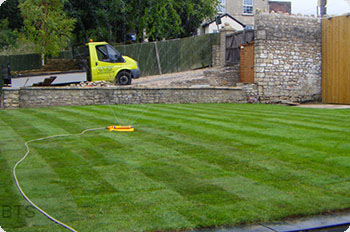
Before laying turf the proposed site should be dug roughly to allow for easier working of the soil, then broken down, raked and trodden level.Your ordered turf will arrive in rolls. Laying the shorter of the two opposing sides first, then start laying the turf in the opposite direction (longer sides). At the end of each run cut off the excess with an old bread knife or the sharp edge of a spade.
Use the remaining pieces to start the next returning run. Tamp down flat and level with the aid of a spade or flatten with a scaffold plank and a bit of weight.If your turf is to be laid during warmer weather or dry spells it should be irrigated well enough to allow for the penetration of water to the soil below, remember that the wind will also dehydrate your turf more than a hot day.
Any cracks, shrinkage or dry spots are obvious signs of insufficient watering and should be remedied immediately by constantly watering until the turf becomes fully established and rooted.
If your water is metered this can be costly, don't skimp on the watering or your turf will literally die of thirst.
